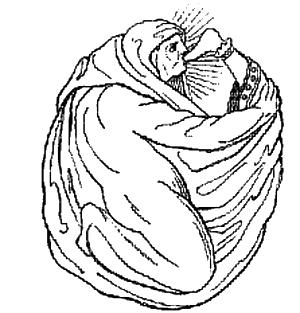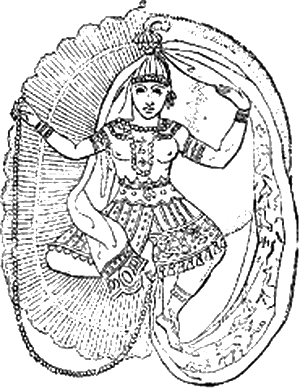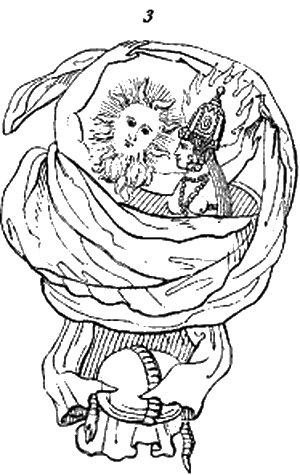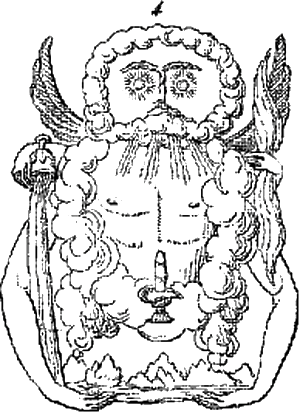I.

The student of Hindu metaphysical religious philosophy, will find most of its important formulations, veiled under a mystical symbolism; to understand which, is a key to the hints in the Upanishads and other esoteric writings.
We propose to give those interested, a series of illustrations from Hindu drawings with descriptions; in the latter, our study of the Kabbalah has been of great assistance.
The figure is a symbolical representation of Brahman (neuter) intwined in Itself.1 It is the highest deity of the Hindus, the principle of the universe; the representation is, of It, at the immediate instant of Its revealing Itself in the emanation of the universe, and before Its entrance into any kind of matter and before Its self renunciation. It symbolises the God—dawn between the pauses of emanative creation, its preservation, and the dissolution of created forms. Wrapped in Its cloak-sphere, Brahman conducts Its toe into Its mouth, perhaps to make, an eternal circle of Itself, perhaps to signify the union of the linga and yoni, perhaps to indicate the retrogression of Itself into Itself, or may be the eternity and unfathomableness of Its nature, plunged in the contemplation of Its own essence. Compare with this the great figure of Neith or Typhe, the Heaven goddess of the Egyptian Zodiac of Dendera. Brahman (neuter) or Para-brahma, i.e. the Great Brahma, as an unrevealed deity, has neither temple or image in India. It is in effect considered in Itself without form or figure, but exteriorly It manifests Itself in many figures and symbols. It is the unit and the multiplied in all, at the same instant, smaller than an atom, it is greater than the whole universe, which cannot contain it, and is ineffable and inexpressible in Its essence. The ancient Hindus say of it in the Vedas:—”Brahman is eternal, the being above all others, revealing Itself in felicity and joy. The universe is Its name, Its image, but that first existence, which contains all in Itself, is the soul really existing. All the phenomena have their cause in Brahman, It is not limited by time or space, is imperishable, is the soul of the world and of each particular existence.” * * * “That universe is Brahman, it comes from Brahman, exists in Brahman, and it will return to Brahman.”
“Brahman, the Being existing in Itself, is the form of all wisdom and of all the worlds without end. All the worlds are made only one with It, because they are through Its Will. That eternal Will is innate in all things. It reveals Itself in the emanation (or creation), in the preservation, and in the destruction (which is also a re-creation), and in the movements and forms, of Time and Space.” The Atharva-Veda says:—”All the gods are in (Brahman) as cows in a cow-house. In the beginning Brahman was this (universe). It created gods. Having created gods, It placed them in these worlds, viz: Agni in this world, Vayu in the atmosphere, and Surya in the sky.2 And in the worlds which are yet higher, It placed the gods which are still higher. Then Brahman proceeded to the higher sphere.” This is explained by a commentator to be Satyaloka,3 the most excellent limit of all the worlds. In the “Taitteriya Brahmana” it is; “Brahman generated the gods, Brahman (generated or emanated) this entire world. Within It are all these worlds. Within It is the entire universe. It is Brahman who is the greatest of beings. Who can vie with It.” Brahman (neuter) is the only real eternal true essence; when It passes in to actual manifested existence It is called Brahma; when It develops Itself in the universe It is called Vishnu, and when It again dissolves Itself into simple being, It is called Siva; all the other deities are only symbols or manifestations of the eternal neuter Brahman.4
The Vishnu Purana says: “Glory to Brahman, who is addressed by that mystic word AUM,5 who is associated eternally with the triple universe (heaven, sky, earth), and who is one with the four Vedas. Glory to Brahman, who both in the destruction and renovation of the universe is called the great and mysterious cause of the intellectual principle, who is without limit in time or space, and exempt from diminution and decay, etc. To that supreme Brahman be for ever adoration.”
In its highest development, the doctrine of the Vedas is a rational and philosophical pantheism, combined with the most ideal, pure, and absolute monotheism, that the mind can conceive. The doctrines as to Brahman (neuter) in their higher conceptions, arc similar in many respects to the exalted ideas as to the Ain Soph or Non Ego, of the Kabbalah.
Brahman, the Eternal, in Itself, Being, goes out of Its profundity in Its eternity, to emanate the universe of all the things, and undeniably establishes that great law of production, through the opposition and yet a harmonious blending, as to which, all nature offers everywhere a similitude, evidence, and image. Its first emanation is the creating energy, force or potentiality, which manifests Itself in Time, the mother and the matrix of the existences, that is the Sakti, Para Sakti or Maya, the first virgin and first female or plasticity, containing all in germ, symbolized by the Yoni. Its spouse, the spiritualizing, the man-type, is symbolized by the Lingam.
II.

This figure represents Brahma-Maya or Mahat-Maya, Brahma Viraj, or the great Illusion.
The androgene or male-female, the Great Appearance, the first revelation of the Being or Brahman (neuter), under the form of the double-sexed first emanation. The neuter, became male and female, by separation into the male, positive, forming the spiritual—the entities or the noumena, and his sakti or female, the negative, or plastic, matter, the illusionary or phenomenal existence. The sakti, is his developing energy, force or potentiality. This symbol, the divine type of the first male and female, which can be compared with the terrestrial Adam before the final separation of Eve, is really in consonance with this Adam’s perfect ideal, the Adam Kadmon or Heavenly Adam of the Kabbalah. The Brahma-half is on the right side, the good side, man’s, the Maya-half is on the left, the evil side, the woman’s. So according to the Hebrew sacred writings, through Eve the woman, evil was brought into the world. Compare with this the Greek myth of Pandora. Issuing from the linga-yoni is the pearl chain, or connected circle of the existences, looked upon as united atoms, and the symbol of all the existing. It is held up by the hand on the male side.
Brahman (neuter), appears here as manifested in the male in union with the female sakti, of the preformatory imagination, as the nine creative monarch and Pearl King, richly decorated with the circles of the soul-monads and atoms. On his head is the world egg cap. The veil of the existences, upon which are woven the ideas or models of the to-be-emanated existences, flows from the linga-yoni to the highest part of the head and thence down the right side. He as the male, has a tendency to twist himself upon himself and his face bears the stamp of deep meditation. The aureole of fire is on the male side and from it scintillate sparks upon the veil of Maya. On the Maya side, the attitude is that of joy or dancing; the hand raised as if in play, holds up the veil, bells are hanging on her robe and singularly the Egyptian hieroglyphic for the water of life is shown; while the bust is developed. Portrayed upon the veil are the prototypes of the creatures. Compare the symbolism of the girdle of Aphrodite and that of Venus.
As the double spouse of Brahman (neuter) considered apart and in opposition to It. The Brahma-Maya is the life in nature, of which, Brahman (neuter) is the soul. The Brahma-Maya is that blind energy and force, potential and powerful, and eternally fecund, which is incessantly producing under forms which are without cessation renewed; and which is adored in India to-day, as the Great Mother, the Universal Mother, in other words all nature deified. Maya is the mother of Love or Desire, the first principle or affinity of all affection, creation, matter. She is even matter itself, but the primitive subtile matter co-existing with God (Brahman, neuter) from all eternity, contained in It, and symbolized by the three colors, red, white, black; the three qualities or powers of creation, preservation and destruction, consequently the Trimurti, and also the three gunas (qualities), Truth, Action, and Indifference, of the Bhagavad Gita.6 It is Maya, who through the attraction of her beauty, causes the Most High, from the bosom of Its ineffable profoundity, forgetting Itself, to unite Itself, in the intoxication of desire with that divine enchantress.
The mysterious veil, which she had woven with her hands, received entirely from both, and the thought of the Eternal Almighty became fecundated, and fell into Time. The innumerable forms of the creatures, represent the perfect ideals woven upon the magic tissue, the woven warp and woof of all existence, with which veil Maya7 envelops her spouse and
causes the recurrence of the gift of life.
III.

This figure represents the Mystic Brahma espousals with Parasakti. The latter is the divine principle of intellectual emanative potentiality or energy, and the ideal of archetypal womanhood. The Sakti is conceived of as the female part of the energy of Brahma’s intellectual, creative power and creative wisdom. Brahma is here the true Para-Brahma, and Para-Sakti a true Para-sarasvadi. The sexless in Brahman (neuter) is here transmuted into the male or energizing power, as the principal symbolic type of the divine emanative, yet immanent, creative power, as the masculine principle of the ideal or Great Androgynic Man or the Makrokosm; and the flaming Sun is here depicted as the flaming sun-face, representative of the male-active deity, also called Purusha. The Sakti or Para-Sakti, the fructifying energy and potentiality of Brahman’s wisdom, wears upon her head a bright fire-flaming crown or nimbus.
The veil surrounding them, is the mystic veil produced by the ideation of the eternal thought of the eternal Mind. In the left hand of the sun-figure on the first finger, is carried a bird or perhaps a dove, which is intended to symbolize the flight of the ideal creation from the eternal Mind before the appearance of that which appears to us to be the real world. In the right hand he holds the end of the mystic veil. On the head of Maya—the woman—is the world-egg cap. Below, in the shadow of the spherical cloak of the God-dawn, is seen the world-egg surrounded by the spiritualizing Ananda the snake of eternity, which as if asleep and inactive, is suspended around the egg.
In India the principal general symbols are fire and water, sun and moon, man and woman, bull and cow, the linga and yoni, the lotus and the sacred fig (ficus indica). The lotus is formed of red, white and blue colors; blue is considered the same as black.
IV.

AUM symbolized as in unison with the attributes of the Trimurti, as the symbolic foundation of the elementary universe. This has a certain connection with figures Nos. 1 and 2 and 3.
The idea is to represent the mystic body of Brahman (neuter) and the ideal type of the Trimurti. The representation is of a four-handed cloud picture. A wreath of clouds forms the outline of the head which is without any tiara. Two suns indicate the eyes without lids, always open. This symbolism is also found in the Hebrew books, e.g. the Zohar. The nose and eyebrows are formed by a palm tree divided on the top, in the centre. This tree was considered as androgynous. The mouth is merely an opening in the clouds; from it emanate, four principal rays, the four-worlds of the Kabbalah. AUM is winged, Brahman (neuter) is not, for the latter is also AUM—Prana, the breath of the highest life and mystic carrier of the Will of Brahman (neuter). AUM is the bird of the Brahman Desire or Wish.
The four hands of AUM are holding the archetypes of the four elements, fire, water, air, earth, in their height and depth. The lower are supporting the Himalayan Mountains, the mountains of the gods. From which comes the German Himmel i.e., Heaven. The linga yoni is shown as the symbol of all the creative and emanative powers which lie in the mystic cloud garment of AUM. In this figure are nearly all the principal symbols of the Brahmanical religious metaphysics.
The bond which unites Prakriti to Brahman (neuter) is Prana, the subtile body of Brahman, the form of the Being, the divine breath, the principle of the organism, the respiration so to say, of the Deity; in Sanskrit it also means “breath of man,” more correctly it is AUM, the first form of the creator, the Sun engendered before Time, the first Word (the Logos) which went from Its mouth, the ‘Hokhmah or Wisdom of the Kabbalah, when It prepared its work, the creative Word. Prana and AUM are confounded in Maya, and as it, they have formed the Cow. AUM is the son of Maya as he is the son of Brahman (neuter), because Maya is Brahman. AUM is the first born Word or Logos of the Deity, the Memrah of the Jews, the Honover of the Persians, the origin of the Vedas. It has revealed and manifested all the emanated things, the so-called creation. It appeared before all things, and contains all qualities, all the elements, and is the name and body of Brahman (neuter), and consequently as infinite as It. The Will, Desire, Word is the master architect and creator of all the things. Brahma meditating upon the divine Word, therein found the primitive water, the common bond of all the creatures, the primitive fire, and the Trimurti of the Vedas, also the worlds and universal harmony of all the things. The image of AUM is the Cow, which is also a symbol of the universe. The universe was concealed and at first was hidden under the waters, and the waters were in Atma. These waters are those without any shores, all that which exists is water, and the water and AUM make but one; these primitive waters are the sea of Maya, the celestial ocean of all existence.
There are to be found further in this symbolical picture many other suggestions flowing from the Ancient Aryan or Hindu system. That system is believed to contain in germ all the others which have since arisen, as: the Hermetic, the Jewish, the Christian and others. Space, however, forbids a more extended explanation at present, and the student is recommended to study the four which have appeared in this magazine.
1. Taken from the Glauben, Wissen und Kunst der alten Hindus, etc., von Niklas Muller, Erster Band, Mainz, 1822.
2. Fire, Aether, Light.
3. Satya-Loka, the place, world, or region of Truth.—[Ed., W.Q.J.]
4. See Indian Wisdom by Monier Williams, p. 12
5. This occurs at the beginning of prayers, etc., as our word AMeN occurs at the end. It is so sacred that none must hear it pronounced. Originally its three letters typified the three Vedas, afterwards it became a mystical symbol of Brahma, Vishnu and Siva in unity; See further as to AUM supra.
6. These three qualities are explained by Krishna in the Bhagavadgita, as Satwa good or inactive being purely spiritual; Rajas bad and active; and Tamas inactive or indifferent and bad. They exist in every human mind and are mingled in greater or less proportions at all times, according to the individual and also according to his varying circumstances. His teaching in regard to the Tamo guna is the same as that taught in the Christian Bible, for he says that for the indifferent man there is no salvation—he is as it were “ejected like a broken cloud;” and in I James v, 6, 7, the doubting man is declared incapable of obtaining anything, while in Rev. iii, 16, the Laodiceans are accused of being neither cold nor hot, that is of being indifferent, and they are condemned to be “spewed out of the mouth,” which is the same as the fate described as awaiting those in whom indifference predominates, Krishna declaring that they become more and more deluded at each succeeding generation until at last they reach the lowest round of the ladder in the shape of primordial matter. The difference between the two schools is, that Krishna’s allows the doctrines of Reincarnation and Karma, while the modern Christians, blind to their own Bible, reject these supremely important laws, or rather ignore them as yet. [Ed., W.Q.J.]
7. Maya is the Sanskrit for illusion. [Ed., W.Q.J.]